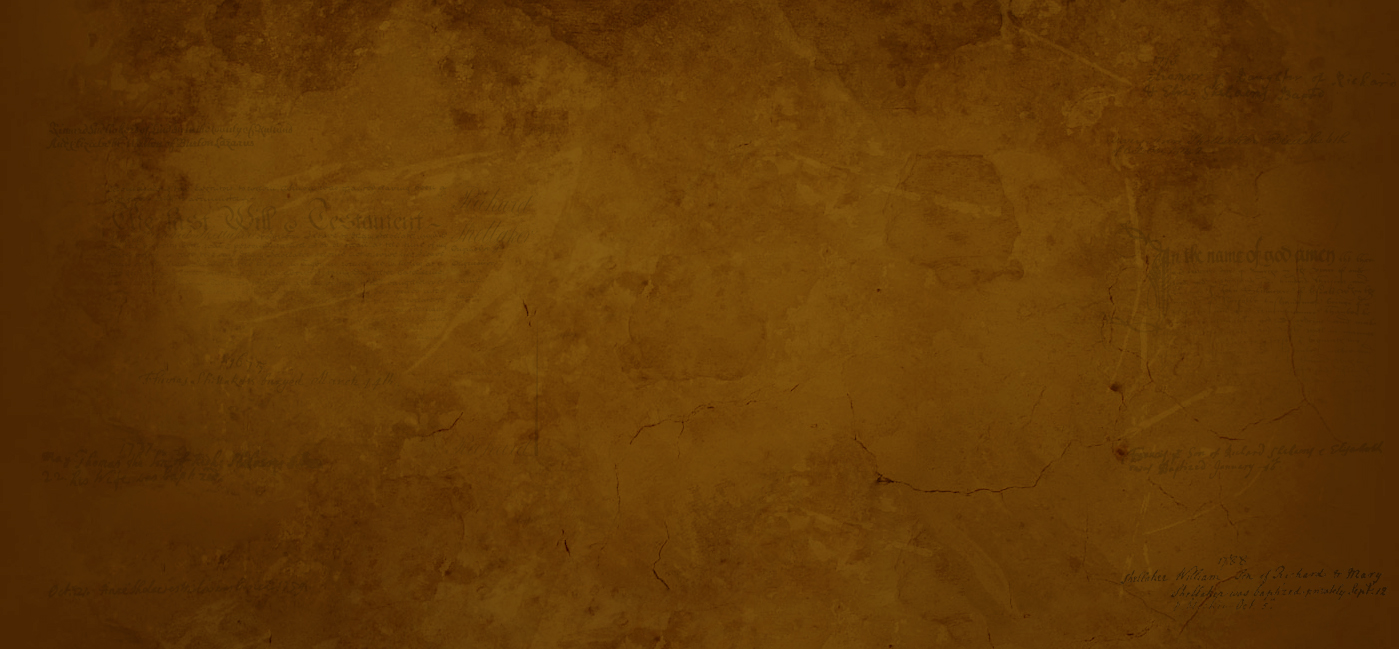

When I first started researching the Shellaker family back in 1974 I was unable to delve any further back than the year 1827 as my activities at that time were restricted to searching random graveyards around Billesdon and Tugby for gravestones inscribed with the family name. The date of 1827 was discovered in Tugby Churchyard on the gravestone of 11 month old Mary Ann Shellaker who died on the 28th of April in that year. She was the daughter of William and Sarah Shellaker who lived in that village.
Around two decades later but still in the pre-internet days, I made the first of numerous visits to the Leicestershire & Rutland Record Office and worked back through the Census records for Tugby, first for 1881 and then backwards through 1871, 1861 and 1851 and it was in the latter, the Census of 1851 I found the evidence of which I was seeking – the birthplace of William Shellaker. Below is the section of that 1851 Census record which identifies his birthplace as being the village of Lyndon in the county of Rutland.
1851 – Section of Census showing William Shellaker’s birthplace as being Lyndon in Rutland
The words ‘Rutland : Lyndon’ can be seen in the top right of this image, directly above the birthplace of William’s wife Sarah which is recorded as ‘Lincolnshire: Spittle Gates’.
Leicestershire & Rutland Record Office
This Records Office holds the parish records for Lyndon and as I started searching through these records it soon became very apparent these records contained numerous entries relating to ‘Shellaker’ and ‘Shelacres’ – a total of 38 such records. Although these records were full of potential Shellaker forebears it was important to confirm a link to the William Shellaker who lived in Tugby. The information on his gravestone in Tugby Churchyard told me William Shellaker died on the 25th November 1855 at the age of 67 years, making the date of his birth somewhere between the 26th November 1787 and the 25th November 1788.
Within that time span I found a record of a baptism within the Lyndon parish records of a ‘William Shellaker, son of Richard & Mary Shellaker’ which took place, privately on the 12th September 1788, then publicly the following month – on the 5th October. The link was established – this was the record of the baptism of my great, great grandfather.
Further research established that the Shellaker family lived in Lyndon for five generations. What follows is their story……
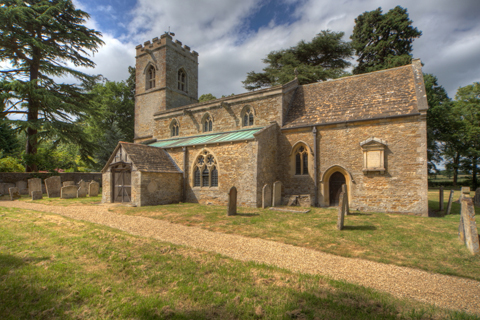 Before our Shelacres / Shellakers ancestors lived in the village of Tugby in East Leicestershire, their home for five generations was the small village of Lyndon in the county of Rutland.
Before our Shelacres / Shellakers ancestors lived in the village of Tugby in East Leicestershire, their home for five generations was the small village of Lyndon in the county of Rutland.
Prior to life in Lyndon the family lived in the village of Loddington on the Leicestershire side of that county’s border with Rutland. Parish records indicate the period of time in which the Shellaker family first lived in Lyndon also coincided with the final few years other members of the family were still living in Loddington.
As I mentioned, the Shellaker family lived in Lyndon for five generations. I have found 38 records of Shellaker/Shelacre baptisms, marriages and funerals which took place in the parish church of St Martin, Lyndon (which is pictured right and is reproduced by permission of LeicesterPhoto). This is considerably a greater number of ceremonies than have taken place in any other church or chapel in the last four hundred years.
In this narrative I highlight each of those generations chronologically starting with the earliest members of the Shellaker family who are recorded in the parish records as living in Lyndon.
The Leicestershire & Rutland Records Office holds the records of Lyndon parish from the year 1580 in which are contains Baptisms, Burials and Marriages which took place in that village from that year onward. However these records are not easy to read and are in some places virtually illegible but I have carefully examined on several occasions, every single page of these records and cannot find any trace of the name Shellaker before a baptism in the year 1682.
Update August 2013 – I recently found a later and very legible transcript of all the Lyndon parish records from the year 1580 created in 1891/92 by the Reverend K.B. Nevinson who was Rector of that parish during the latter part of the Victorian era. Although his transcript did help to clarify one or two previously illegible dates, I was also able to confirm I had already found all of the Shellaker events which occurred within that parish church – a total of 38 such events.
THE FAMILY OF RICHARD & ELIZABETH SHELACRES
Richard and Elizabeth Shellaker were the first generation of the family to live in Lyndon although I cannot find any records of either being born in that village.
The Husband – Richard
From other records, to which I will refer shortly, I know that RICHARD SHELLACRES was born either in 1650 or 1651 but I did not find a record of his birth in the parish records of Lyndon (or in the clearly legible transcript mentioned above.) So it is apparent he was born in another village and not in Lyndon. As can be seen on the Loddington page of this website, there are records of two ‘Shellaker‘ baptisms, one in 1644 and another in the year 1646, in the village of Loddington of ELEANOR and THOMAS SHELAKER. These are the children of another Richard Shellaker and his wife Joan. I believe it is extremely probable the Richard Shelacres mentioned above as living in Lyndon was the younger brother of Eleanor and Thomas. His birth year of 1650/51 is only four years after Eleanor’s baptism so it seems very likely.
So I am reasonably confident in believing Richard Shelacres was born in Loddington c.1650, is a sibling of Eleanor & Thomas and is one of the children of Richard & Joan Shelaker of that village. I speculate he moved to Lyndon, which is around ten miles east of Loddington possibly between 1665 and 1680. One other piece of information – this Richard Shellacre, who I believe was born in Loddington c.1650/51 but moved to Lyndon, is my great-great-great-great-great-great grandfather.
His Wife – Elizabeth
I know, again from other information which I will mention shortly, that Richard’s wife Elizabeth was around 4 years younger than her husband and therefore was born either in the year 1654 or 1655. But again I cannot find any record of her birth in Lyndon but that task was made harder as I do not know her maiden name. I searched the Lyndon parish records for the baptism of a girl named ‘Elizabeth‘ either in 1654 or 1655 but I did not find such an entry. Nor could I find a record in those same parish records, of a wedding of Richard to Elizabeth, which would have been between the years 1672 – 1682.
c.1680 – “Richard Shelacres & Elizabeth – the First Generation of the family to live in Lyndon”
[Direct male ancestors are shown in Blue, the female ancestor in Pink]
One probable conclusion we should consider is that Elizabeth was not born in Lyndon and her marriage to Richard took place in the, as yet unknown village of her birth. So somewhere in the parish records of possibly a neighbouring village could be found their marriage and a record of her baptism – now there’s a challenge for someone! The record of her marriage would obviously include the name ‘Richard Shelacres’ and would reveal her maiden name thereby enabling a search for her baptism record.
NB: To date I have searched without success, for a record of this marriage within the records of the immediate neighbouring parishes of Edith Weston and Pilton and intend to check Manton, Hambleton, Wing and North Luffenham and then plan to search other parishes when time allows.
Please note: As I mention elsewhere in this website there are several variations in the spelling of the surname Shellaker, these include ‘Shellakers’, ‘Shillakars’, ‘Shilakers’ and ‘Shelacres’. This apparent inconsistency of the surname is not a concern. In times past very few people could read or write and consequently people did not know how to spell their own surnames. It would be the responsibility of the parish vicar or his clerk to record the names into the parish records which would be spelt how they thought the surname was spelt based on the sound of the name.
Next Page: Lyndon – The Second Generation
Before the Shelacres / Shellakers moved to the village of Lyndon in Rutland they lived in the East Leicestershire village of Loddington.
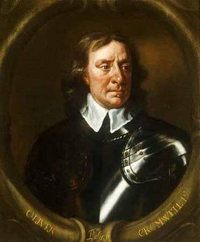 The oldest record of a member of our ‘Shellaker‘ family, whom we can say with a very high degree of certainty is connected to our family, is over 370 years ago. The record is from the year 1644 during which time our country was in the midst of the English Civil War (1642–1651) when Roundheads fought for Parliament under the leadership of Oliver Cromwell (his portrait is on the right) against the Royalist armies of Charles the First – the Cavillers.
The oldest record of a member of our ‘Shellaker‘ family, whom we can say with a very high degree of certainty is connected to our family, is over 370 years ago. The record is from the year 1644 during which time our country was in the midst of the English Civil War (1642–1651) when Roundheads fought for Parliament under the leadership of Oliver Cromwell (his portrait is on the right) against the Royalist armies of Charles the First – the Cavillers.
5th May 1644 – BAPTISM
On Sunday 5th May 1644 there is a record was a baptism of a boy named THOMAS SHEAELEAKER in the church of St Michael & All Saints in the parish of Loddington, a small village in Leicestershire near to the border of the County of Rutland in the English Midlands.
NB. Variations in the spelling of the surname Shellaker, which include ‘Shellakers’, ‘Shillakars’, ‘Shilakers’ and ‘Shelacres’ and that of the spellings of Christian names, should not be a concern.
Few could read or write so most did not know how to spell their own names. The parish vicar or his assistant would be record the names into the parish records, writing names how he thought they should be spelt based upon how the name was pronounced. Interestingly in the parish record the surname of the son Thomas has a very creative spelling of ‘Sheaeleaker’, while in that same record, the father surname is spelt ‘Sherleaker‘. For the Parish Records of Loddington I employed the services of an expert from the Leicestershire and Rutland Records Office who searched the records to confirm the accuracy of the records I had already located and also to supply a transcribed copy of how each record was originally written.
The Village
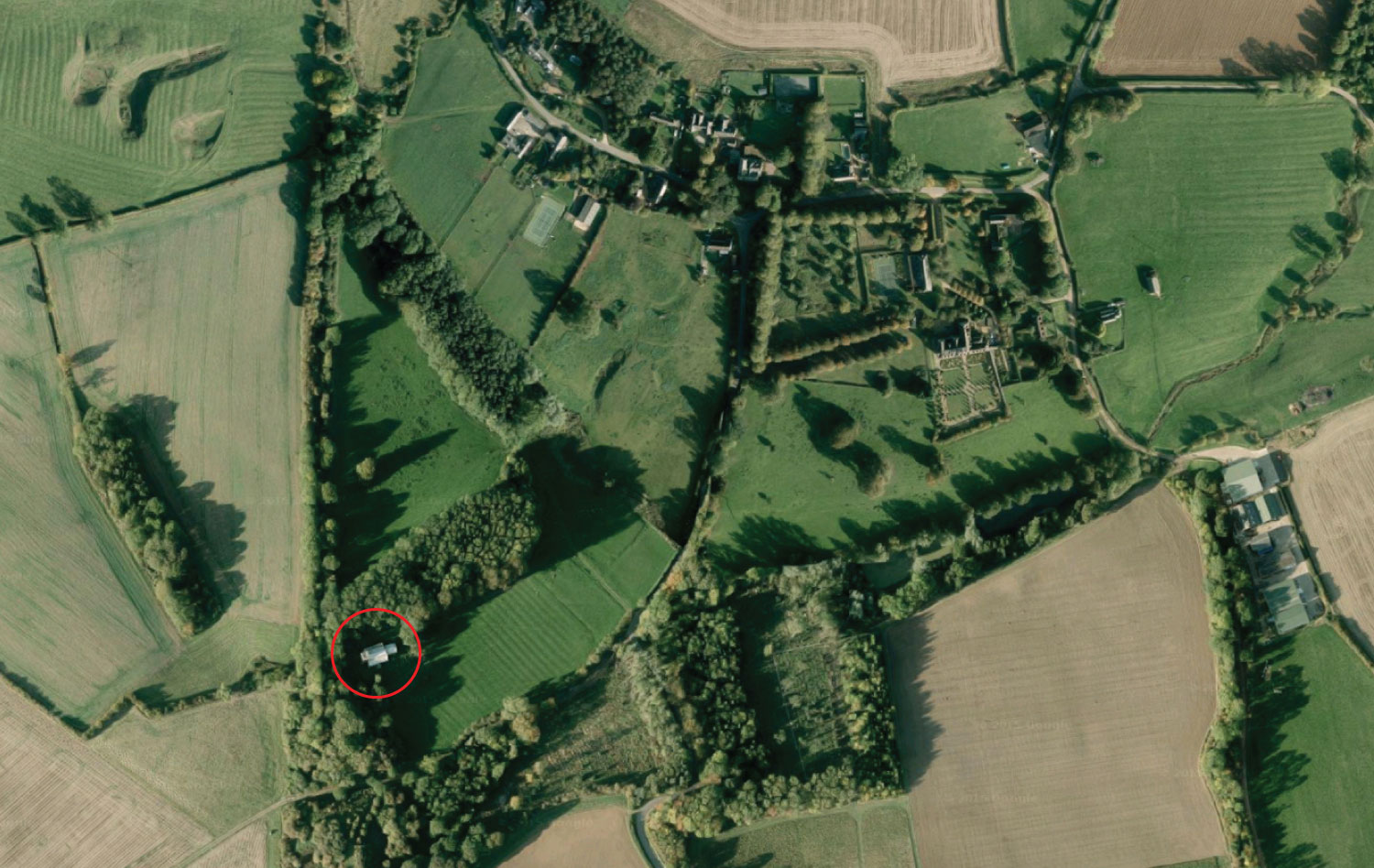 Loddington at that time was a small village (and it so remains). In 1564 , over one hundred years before the birth of Thomas it is recorded that 22 families in Loddington, one of whom, as we now know, was the Shellaker family.
Loddington at that time was a small village (and it so remains). In 1564 , over one hundred years before the birth of Thomas it is recorded that 22 families in Loddington, one of whom, as we now know, was the Shellaker family.
In 1844 the village was recorded as being; ‘a pleasant village in a valley, adjoining Rutlandshire, as a parish of 137 souls’.
Before the plague, the population of the village was likely to be higher than at present and the location of the church, in the middle of a field with no roads and well away from any of the current houses – see image on the right – click on the picture to see a larger version. This is a strong indication that houses were once located around the church before the plague or depopulated for other reasons.
The village of Loddington was enclosed* between 1607 and 1640, changing the landscape and forcing many to seek work elsewhere. The enclosure of the land occurred just prior to the date of this first record of a baptism.
* Enclosure was the legal process in England during the 18th century of enclosing a number of small landholdings to create one larger farm. Once enclosed, use of the land become restricted to the owner, and it ceased to be common land for communal use.
1644 – The Oldest Record (to date)
The record of the baptism of Thomas Sheaeleaker is below and is the third entry for 1644. I have marked the first line of the entry, which runs over two lines, with an ‘x’. The father’s surname is spilt over those two lines.
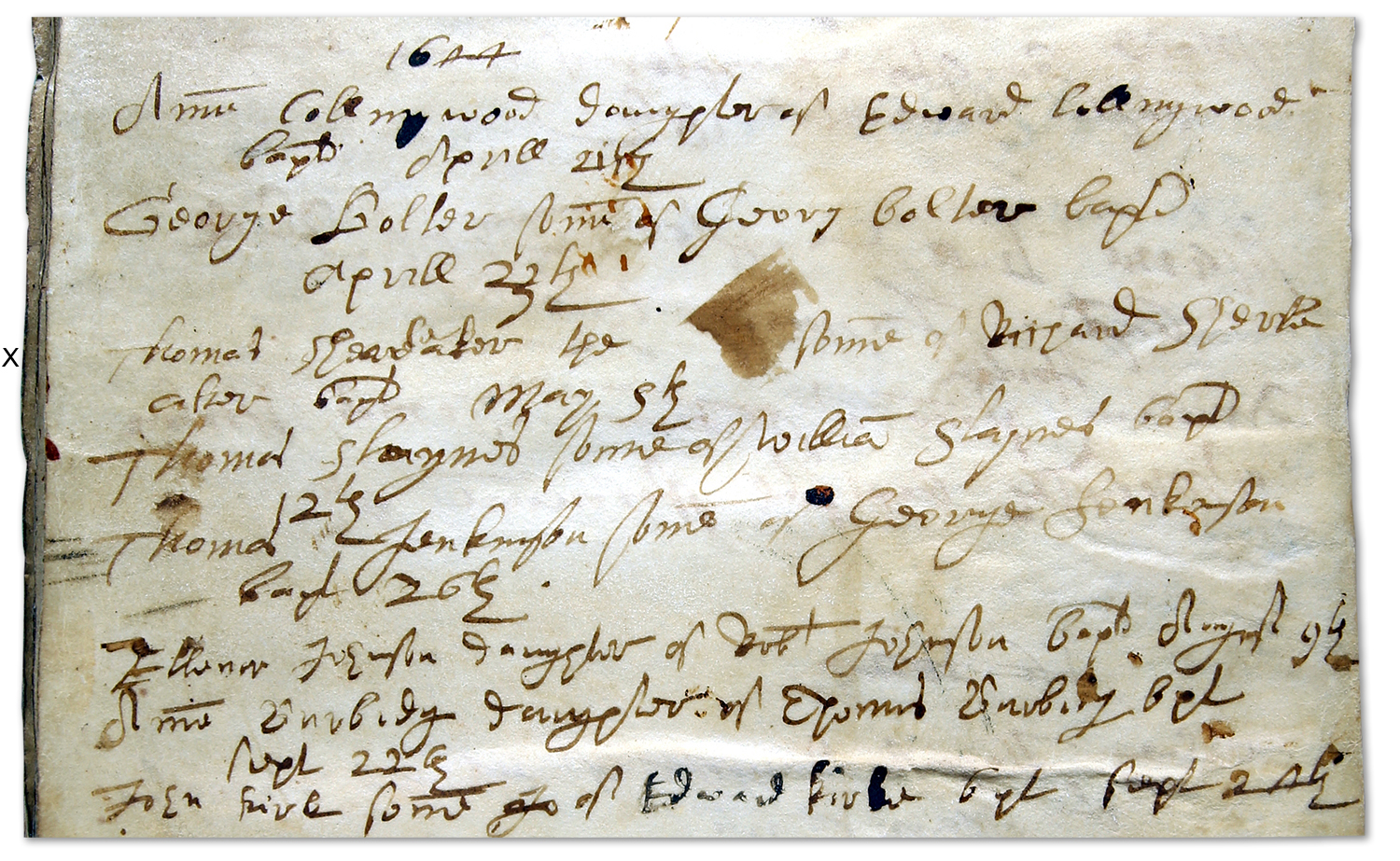
“1644 Thomas Sheaeleaker the sonne of Richard Sherle
– aker bapt. May 5th”
6th July 1646 – BAPTISM
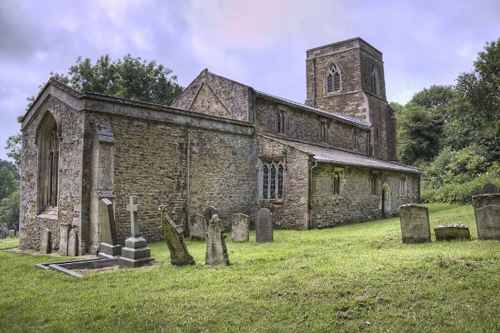 Just over two years later we find the baptism in that same church of a girl named ELLENOR SHELAKAR which occurred on Monday 6th July 1646. Usually baptisms took place on a Sunday and so we could speculate the baby girl was ill at birth which necessitated a prompt baptism.
Just over two years later we find the baptism in that same church of a girl named ELLENOR SHELAKAR which occurred on Monday 6th July 1646. Usually baptisms took place on a Sunday and so we could speculate the baby girl was ill at birth which necessitated a prompt baptism.
The church of St Michael & All Saints, which is pictured right and is reproduced by permission of LeicesterPhoto, dates mostly from the late 13th to early 14th century, although the south doorway may date from an earlier period which would seem to suggest that an earlier structure stood on the site.
Due to the fact there are only around 20 families living in Loddington at that time and that the name of the father is also Richard, we should assume Ellenor was a sister to the two-year old Thomas. Unlike the previous record, this one records the mother’s name, written as ‘Jone‘ which is presumably Joan.
The timing of Ellenor’s baptism was just over a year after the decisive Civil War Battle of Naseby which had taken place relatively closely, a mere twenty miles south of Loddington in nearby Northamptonshire.
With defeat in this battle, King Charles the First lost all chance of winning the war and less than three years later, on 30th January 1649, he was beheaded for high treason.
1646 – “Ellenor, the Daughter of Richard Shelaker and & Jone his wife bapt 6th of July”.
26th May 1671 – MARRIAGE
I also found two clear records of Shellaker marriages; the first in 1671, the second in 1673. The first entry is for the marriage of THOMAS SHELLAKARS & ELIZABETH DAWSON which took place on Friday 26th May 1671 (or ‘about’ the 26th May as it is written in the Parish Records!) Thomas’ marriage is the second entry from the bottom (marked with an ‘x’). The surname ‘Shellakars‘ is undisputedly clear. Thomas was around 27 years old when he was married Elizabeth Dawson.
1671 “Thomas Shellakars & Elizabeth Dawson Maryed about 26th May”
Events at this Time
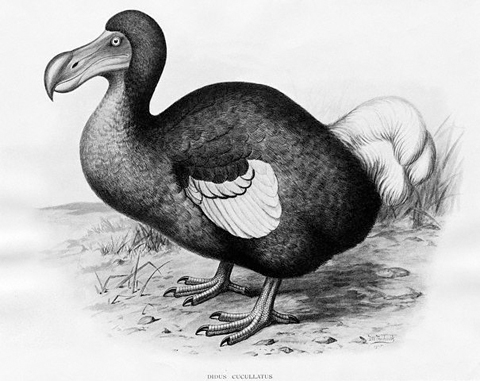 This first wedding took place around a decade after Charles II had been restored to the English throne (1660) and the flightless Dodo bird became extinct (1662).
This first wedding took place around a decade after Charles II had been restored to the English throne (1660) and the flightless Dodo bird became extinct (1662).
In fact the Dodo (engraving on the right) became extinct between the time span of the birth and marriages of Thomas and his sister Ellenor.
It was five years after the Great Fire of London and during a time the Kingdom of England was at war with the Dutch Republic (1672-1674) with sea battles being fought in the North Sea and around New York in the Americas.
It is highly doubtful these events, even if known to the Shellaker family, had any effect upon life in the village of Loddington but it is likely alarming news reached the village of another outbreak of ‘The Black Death’ – the Second Pandemic of the bubonic plague (1665-1666), although the plague, on this occasion, was mainly confined to London.
3rd April 1673 – MARRIAGE
A second ‘Shellaker‘ marriage was recorded two years later in 1673. Undoubtedly the ELLEANOR SHELLAKARS who married CHARLES NEWBY on Thursday 3rd April 1673 is same girl who was baptised in that village on the 6th of July 1646. In 1673 Ellenor would have reached the ages of 26 years old.
1673 “Charles Newby & Elleanor Shellakars Marryed April 3rd per bann.”
The record states the marriage was ‘per bann‘. This means ‘by banns’ – Banns are an ancient legal tradition and are an announcement in church of an intention to marry and a chance for anyone to put forward a reason why the marriage may not lawfully take place.
26th July 1674 – BAPTISM
Fourteen months later, in parish records for the year 1674 is the record of a baptism of ELIZABETH SHELLAKARS which took place on Sunday 26th July 1674. It is extremely probable is the baptism of a child born as a result of the marriage of Thomas Shellakars & Elizabeth Dawson three years earlier in 1671.
I am unsure why Thomas’ wife Elizabeth is not included in this entry in the parish record. I could speculate she had died, possibility in child birth but it should be remembered England at the time was male-dominated and details of the mother of the child were not always entered in such records. The two entries of births directly above that of Elizabeth Shellakar only include the name of the father but the first four entries in this segment include the name of the mother.
1674 – “Elizabeth, the Daughter of Thomas Shellakars, Bapt July 26th.” “N. Barry. vic.”
There is no evidence Elizabeth Shellakars (née Dawson) died at childbirth but if that was the case, her child Elizabeth would have been orphaned in 1675 as I found an entry of the death of a man,who is probably her father. At this time the baby girl would have been less than one year old.
14th March 1675 BURIAL
The entry of the burial of THOMAS SHELLAKARS is on the last line of the section below but it should be said that this man may not be the husband of Elizabeth. It could be the burial of an unknown uncle but no records indicate that Thomas’ father Richard had a brother. Additionally there are no further mentions of a ‘Thomas‘ in the Loddington Parish Records. If this man was the husband of Elizabeth as seems likely, then he died within a year of the birth of his daughter and was around 30 years old when he died.
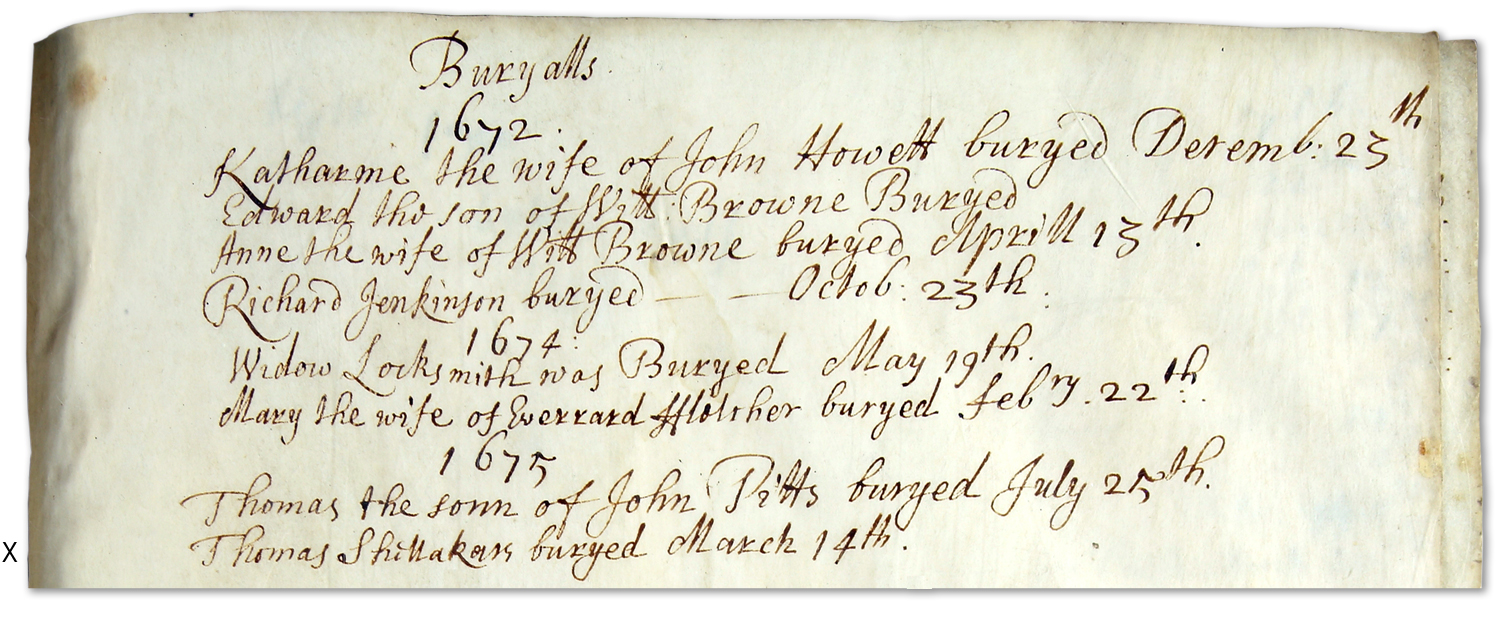 1675 – “Thomas Shellakars buryed March 14th.”
1675 – “Thomas Shellakars buryed March 14th.”
Next Page: Further Shellaker records within the Loddington Parish Records
Surnames are relatively new in our country. Before the Norman Conquest of 1066, people did not have hereditary surnames: they were known just by a personal name or nickname. This was because villages and hamlet were so small each person could be identifiable by a single name.
However as the population increased, it gradually became necessary to identify people in more detail. This lead to names such as ‘John the butcher’, ‘William the short’, ‘Henry from Sutton’, ‘Mary of the wood’, ‘Roger son of Richard’. Over the decade many of these types of names became altered, often by inconsistencies passed on verbally, and their original meaning is now not as evident as it once was.
THE ARRIVAL OF THE NORMANS
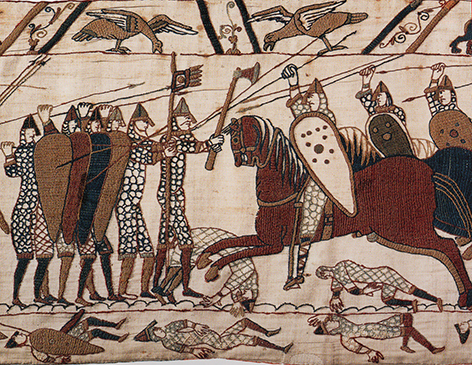 After 1066, Norman barons introduced surnames into England and the practice gradually spread around the country.
After 1066, Norman barons introduced surnames into England and the practice gradually spread around the country.
Initially, the identifying names were changed or dropped but some eventually they began to stick and to get passed on. So trades, nicknames, places of origin, and fathers’ names became fixed surnames – names such as Fletcher and Smith, Redhead and Swift, Green and Pickering, Wilkins and Johnson.
By 1400 most English families, and those from Lowland Scotland, had adopted the use of hereditary surnames. Most Saxon and early Celtic personal names – names such Oslaf, Oslac, Oswald, Oswin and Osway (‘Os’ meaning God) – disappeared quite quickly after the Norman invasion. It was not fashionable, and possibly not sensible either, to bear Saxon names during those times, so they fell out of use and were not often passed on as surnames.
New surnames continued to be formed long after 1400, and immigrants brought in new ones. It is important to remember that both surnames and forenames are subject to variations in spelling, and not only in the distant past. We see our own family name spelt as ‘Shellaker, ‘Shellakers’, ‘Shillakars’, ‘Shilakers’ , ‘Shellacres’ and ‘Shelacre’. Standardised spelling did not really arrive until the 19th century.
There are perhaps 45,000 different English surnames, each one with a history behind it, but most had their origins as one of these six main types.
Occupational
Describing a personal characteristic
From a geographical feature of the landscape
Baptismal names – those that come from a male given name or a female given name or ancestral – signifying patronage.
From the name of an estate
From an English place name
I will go through these options individually to explain how such surnames derive and consider each type as an option behind the surname ‘Shelacre / Shellaker’.
And I will then put forward my own, as yet unproven theory, as to which of these types of surname which I consider to be the the most probable as being the origin of our family name…….
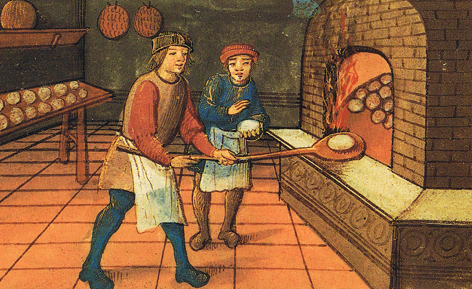 Occupational names are relatively common and easy to understand, as they identify people based on their job, trade or their position in society.
Occupational names are relatively common and easy to understand, as they identify people based on their job, trade or their position in society.
If a man was called, for example, “Richard Baker”, it indicated he baked bread for a living and because sons very often followed their father’s occupation the surname continued across generations, even when baking bread was no longer the trade of that person.
Some occupational surnames are very obvious e.g. Carpenter, Smith, Potter, Cooper, Mason, Tailor or Taylor, Spinner, Weaver, Dyer, Thatcher, Tyler, Slater, Miller, Baker, Cheeseman, Spicer, Cook, Fisher, Shepherd, Carter, Clarke, Skinner and Gardener.
Some occupational names are not so obvious; a sawyer was a man who sawed logs, a turner was a man who turned wood on a lathe and made things like wooden bowls and a roper made ropes.
Likewise a mercer was a dealer in fine cloth, a bowyer made bows and a stringer or stringfellow made the strings for bows while a fletcher made the shafts for arrows and attached the flights.
Could ‘Shellaker‘, ‘Shelacres‘ or any of its other derivatives, be an ‘OCCUPATIONAL SURNAME’?
There is a substance named ‘Shellac‘, which is is a resin secreted by the female lac bug, on trees in the forests of India and Thailand. The substance has been in use for centuries – there is written evidence to show shellac goes back 3,000 years.
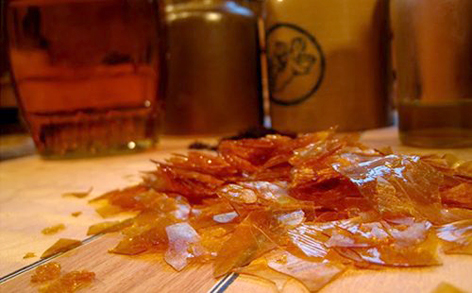 It has many uses, it is used as a wood finish in the western europe, it is an element of the traditional “French polish” method of finishing furniture. However the uses of ‘Shellac’ are incredibly obscure and diverse; dental technology, a binder in Indian Ink, it adds shine to Citrus fruit, it is used in the process of making woodwind instruments, ballet shoes, in the watchmaking process, firework, jelly beans and it is used as a nail treatment.
It has many uses, it is used as a wood finish in the western europe, it is an element of the traditional “French polish” method of finishing furniture. However the uses of ‘Shellac’ are incredibly obscure and diverse; dental technology, a binder in Indian Ink, it adds shine to Citrus fruit, it is used in the process of making woodwind instruments, ballet shoes, in the watchmaking process, firework, jelly beans and it is used as a nail treatment.
So could someone who works with Shellac have become known as a ‘Shellac-ker’?
I think that idea is very doubtful. People who use Shellac on wood are known as ‘French polishers’ and many centuries ago they were known as ‘varnishers’.
Because the uses of Shellac are so diverse, and I’ve listed only a few uses, it is used by many different trades – there was not a occupation who solely used this material. Consequently I think an ‘occupational‘ reason, based upon the use of Shellac, as being the origin of the name Shellaker is extremely improbable.
Some surnames had their origins based on nicknames that described the person. These include those used to describe the height of a person such as ‘Short’, ‘Long’ and ‘Little‘. Example of this type of name include colouring, skin or hair or perhaps clothing; ‘Black’, ‘White’, ‘Green’ and ‘Red‘ or another characteristic trait of the person; ‘Stern’, ‘Strong’ and ‘Swift‘.
Could a personal characteristic, such as the type mentioned above, be the origin of the surname ‘Shellaker‘?
Try as I might I cannot think how it could be so. Consequently I think a ‘physical or personal characteristic’ of one of our ancestors as being the origin of the name Shellaker is extremely implausible.
Next Page: Other options are considered